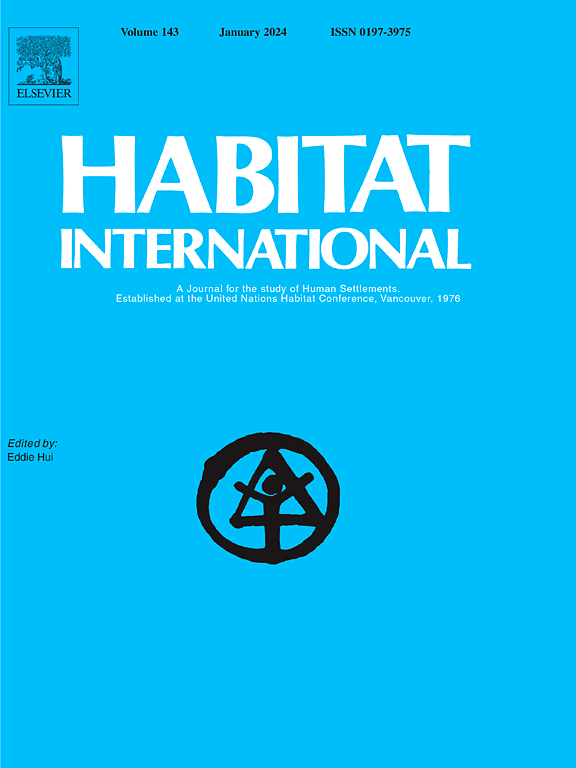Urban human settlement quality refined assessment and its spatial relationship with human activity intensity in arid area: A case study of Urumqi, China
IF 7
1区 经济学
Q1 DEVELOPMENT STUDIES
引用次数: 0
Abstract
In the unique geographical contexts of ecological vulnerability and climate sensitivity, urban human settlement in arid areas faces dual pressures: ensuring human well-being while protecting the natural environment. There exists a complex interplay between human activities and human settlement in these regions. However, current research on urban human settlement in arid areas remains insufficient in comprehensively considering both the natural and cultural environments, and integrated studies on the spatial relationship between human activity intensity (HAI) and urban human settlement quality (HSQ) are still lacking. To address this gap, this study constructs an evaluation framework for urban HSQ in arid areas from an integrated perspective that combines natural and cultural environments. The framework includes three dimensions: natural environment quality, living facilities quality, and traffic accessibility quality. Using Urumqi, a major city in northwest China, as a case study, this paper analyzes the spatial relationship between urban HSQ and HAI. Results reveal a distinct "core-periphery" structure in Urumqi, where deficiencies in life and public service facilities are the primary obstacles to improving HSQ. Although a significant global spatial positive correlation exists between HSQ and HAI, spatial matching is poorly aligned. The future development of urban human settlement in arid areas should not only focus on enhancing natural environment quality but also actively ensure the provision of cultural environment to meet the needs of human activities. Additionally, effective measures should be taken to reduce disparities in urban HSQ between core and peripheral areas. This study provides new insights into the development of urban human settlement in arid areas and holds significant implications for achieving harmonious coexistence between humans and nature.
干旱区城市人居环境质量精细化评价及其与人类活动强度的空间关系——以乌鲁木齐市为例
在生态脆弱性和气候敏感性的独特地理背景下,干旱地区的城市人居环境面临着双重压力:既要确保人类福祉,又要保护自然环境。这些地区的人类活动与人居环境之间存在着复杂的相互作用。然而,目前对干旱区城市人居环境的研究还缺乏对自然环境和人文环境的综合考虑,缺乏对人类活动强度(HAI)与城市人居环境质量(HSQ)空间关系的综合研究。为弥补这一不足,本研究从自然环境与人文环境相结合的综合视角构建了干旱区城市HSQ评价框架。该框架包括三个维度:自然环境质量、生活设施质量和交通可达性质量。以乌鲁木齐市为例,分析了城市HSQ与HAI的空间关系。结果表明,乌鲁木齐市存在明显的“核心-边缘”结构,生活和公共服务设施的不足是影响城市HSQ提升的主要障碍。尽管HSQ与HAI在全球范围内存在显著的空间正相关,但空间匹配度不一致。未来干旱区城市人居环境的发展不仅要注重提高自然环境质量,而且要积极保证提供满足人类活动需要的人文环境。此外,应采取有效措施缩小城市HSQ在核心和外围地区之间的差距。该研究为干旱区城市人居环境的发展提供了新的视角,对实现人与自然的和谐共处具有重要意义。
本文章由计算机程序翻译,如有差异,请以英文原文为准。
求助全文
约1分钟内获得全文
求助全文
来源期刊

Habitat International
Multiple-
CiteScore
10.50
自引率
10.30%
发文量
151
审稿时长
38 days
期刊介绍:
Habitat International is dedicated to the study of urban and rural human settlements: their planning, design, production and management. Its main focus is on urbanisation in its broadest sense in the developing world. However, increasingly the interrelationships and linkages between cities and towns in the developing and developed worlds are becoming apparent and solutions to the problems that result are urgently required. The economic, social, technological and political systems of the world are intertwined and changes in one region almost always affect other regions.
 求助内容:
求助内容: 应助结果提醒方式:
应助结果提醒方式:


